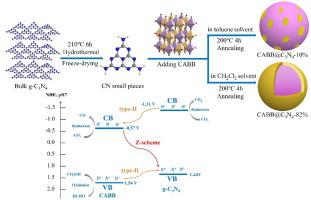Applied Catalysis B: Environment and Energy ( IF 22.1 ) Pub Date : 2020-09-21 , DOI: 10.1016/j.apcatb.2020.119570 Yingying Wang , Hanlin Huang , Zhenzhen Zhang , Cong Wang , Yuying Yang , Qi Li , Dongsheng Xu

|
Solar-energy-driven CO2 conversion into value-added chemical fuels holds great potential renewable energy generation. However, most of the photocatalysts facilitate a two-electron reduction process producing CO, hard for the eight-electron CH4 production pathways which can stockpile more solar energy for further utilization. Herein, we developed an in situ assembly strategy to fabricate the lead-free perovskite Cs2AgBiBr6@g-C3N4 Z-scheme system in toluene and the Cs2AgBiBr6@g-C3N4 type-II heterojunction structure in CH2Cl2. By combining the reducing ability of the conduction band of g-C3N4 and the oxidizing ability of the valence band of Cs2AgBiBr6 perovskite, this Z-scheme system exhibits superior CH4 production in photocatalytic CO2 reduction, in contrast to the high CO selectivity for the heterojunction photocatalysts, which is 10-fold and 16-fold higher than that of pure g-C3N4 and pure CABB, respectively. The stability (four consecutive photocatalytic cycles in solvent methanol as sacrificial reagent without obvious decrease of efficiency) and the mechanism (the prominent activity and the high CH4 production selectivity boosted by Z-scheme system) were demonstrated. In this work, the first report for constructing lead-free halide perovskite Z-scheme and type-II photocatalytic systems for the regulation products selectivity of CO2 reduction reaction provides a promising strategy for the fabrication other types of inorganic/organic heterojunction systems.
中文翻译:

无铅钙钛矿Cs 2 AgBiBr 6 @gC 3 N 4 Z方案体系,用于在光催化CO 2还原中提高CH 4的产生
太阳能驱动的CO 2转化为增值化学燃料具有巨大的可再生能源发电潜力。然而,大多数光催化剂促进了产生CO的两电子还原过程,这对于八电子CH 4的生产途径来说是困难的,因为它可以储存更多的太阳能以供进一步利用。本文中,我们开发了一种原位组装策略,以在甲苯中制造无铅钙钛矿Cs 2 AgBiBr 6 @gC 3 N 4 Z方案体系,并在CH 2中制造Cs 2 AgBiBr 6 @gC 3 N 4 II型异质结结构。氯2。通过结合gC 3 N 4的导带的还原能力和Cs 2 AgBiBr 6钙钛矿的价带的氧化能力,该Z方案系统在光催化CO 2还原中表现出优异的CH 4生成,与之相比,高异质结光催化剂的CO选择性分别比纯gC 3 N 4和纯CABB高10倍和16倍。稳定性(在溶剂甲醇中作为牺牲试剂连续四个光催化循环,效率没有明显降低)和机理(突出的活性和较高的CH 4Z-方案提高了生产选择性)。在这项工作中,第一篇关于构建无铅卤化物钙钛矿Z方案和II型光催化体系以调节CO 2还原反应选择性的报告为制备其他类型的无机/有机异质结体系提供了有希望的策略。


























 京公网安备 11010802027423号
京公网安备 11010802027423号